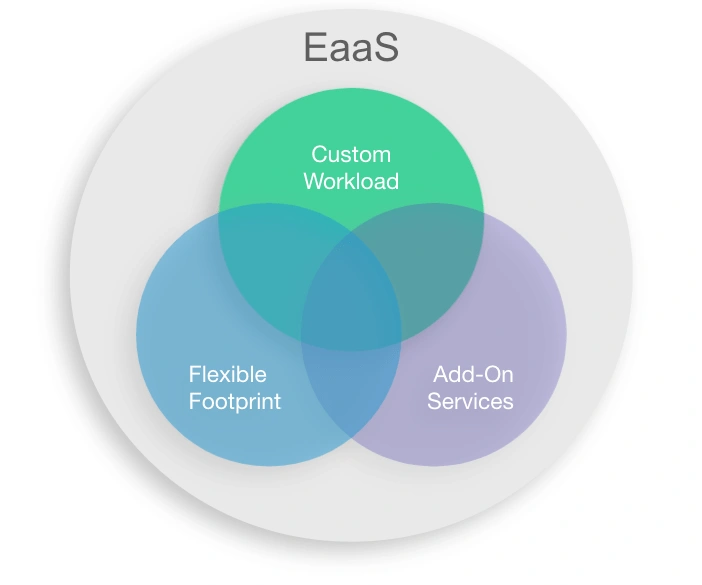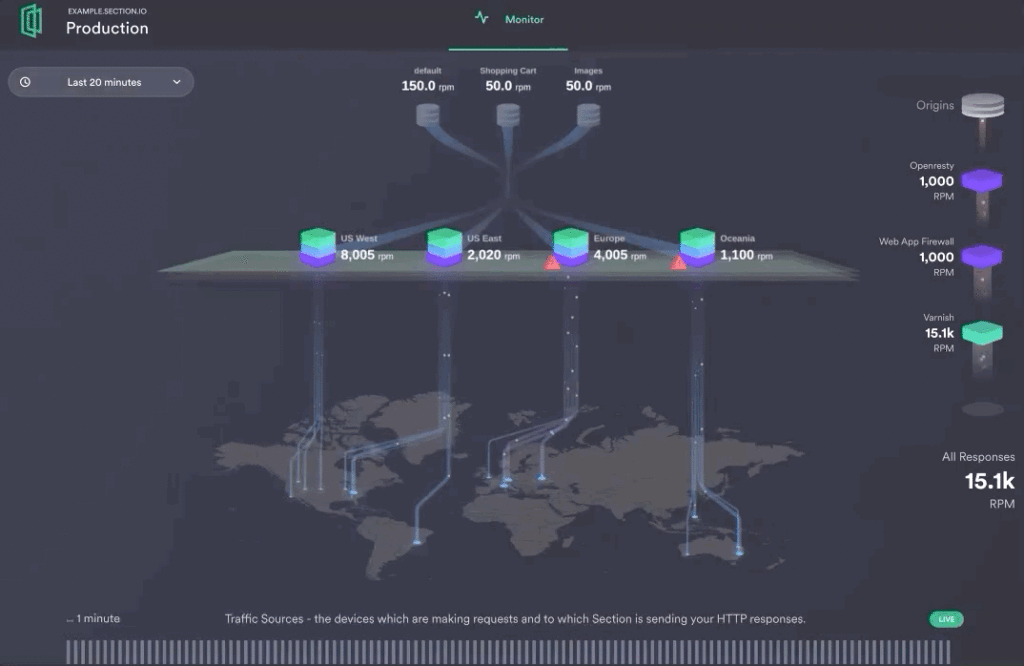The “as a service” model is relied on heavily by companies today to meet a wide range of needs. Software as a Service (SaaS) may be the most recognizable of these services, but Platform as a Service (PaaS) and Infrastructure as a Service (IaaS) are also widely used.
A newer addition to the “as a service” catalog is Edge as a Service (EaaS). Edge computing—the use of cloud computing to put latency-sensitive and latency-critical workloads as close as possible to end users—provides tremendous performance improvements and data backhaul reductions. EaaS empowers innovators like software providers and infrastructure providers to build, integrate, and operate edge services efficiently and effectively.
Not surprisingly, moving services to the edge can be complicated. Fortunately, EaaS helps make the transition much easier and speeds up time to value. Companies looking to better serve their customers and offload complexities for their teams are increasingly turning to EaaS. With EaaS, technical product teams get the operational enhancements they need without the time, effort, and capital it takes to train and educate internal IT teams that may not have expertise in building and operating distributed systems.
What to look for in an Edge as a Service solution
There are many factors to consider when evaluating EaaS solutions, and feature sets generally fall in one of two buckets, must-haves or nice-to-haves. The following five characteristics are absolute table stakes when it comes to selecting an EaaS solution.
1. Granular control
The right EaaS solution enables you to focus on determining the needs of your team and your customers first, and then leverage the power of EaaS technologies to design and implement solutions that are tailored to meet those unique requirements. In order to achieve this, EaaS solutions must provide granular, code-level control to seamlessly integrate edge solutions into existing stacks and workflows.
How the Webscale CloudFlow platform enables granular control
The CloudFlow Control Plane is built on top of a GitOps paradigm, enabling DevOps teams to configure and manage their distributed environment from a centralized, integrated, secure control plane using familiar tooling.
2. Exceptional flexibility
Many organizations just beginning their Edge journeys start by exploring the capabilities of familiar Cloud and Content Delivery Network (CDN) service providers. Cloud providers (e.g. AWS, Google, Azure, DigitalOcean, etc.) are well-versed at supporting diversity of edge workloads, but often fall short in enabling technical product teams to easily deploy and manage those workloads across a distributed footprint. CDN providers, on the other hand, have deep experience in distributing workloads across global edge networks, but the workloads supported are limited to static asset delivery and other basic, fixed functions, without support for truly custom workloads.

EaaS solutions are specifically designed to solve for the shortcomings of existing Cloud and CDN capabilities, and therefore must be flexible enough to not only support custom workload requirements, but must also have the network reach and adaptability to distribute workloads in the most suitable locations to meet desired outcomes in a cost-effective manner. In choosing an EaaS solution, be sure to evaluate not only its ability to provide the solution you need today, but also consider how the solution can evolve as the company’s needs increase or evolve.
How the Webscale CloudFlow platform solves for flexibility
Flexibility is at the core of the CloudFlow platform. The CloudFlow Edge AppSpace enables organizations to easily distribute custom workloads and applications (e.g. containers, serverless, Node.js), while also offering out-of-the-box, add-on edge security and performance modules from leading solution providers. In addition, organizations benefit from CloudFlow’s Federated Edge and Multi-Cloud Network (AWS, Azure, Google, DigitalOcean, Equinix, Akamai, Lumen, Rackcorp) powered by CloudFlow’s patented Adaptive Edge Engine, along with the ability to bring your own infrastructure into a project.
3. Advanced security and compliance
Security and compliance are top concerns for every company today. Edge computing topologies can help application architects meet compliance requirements, while also mitigating the impact of potential security breaches. Processing data closer to end devices allows for earlier threat detection and mitigation, before attack agents are able to penetrate mission-critical operations.
EaaS solutions must be designed with protection in mind, providing excellent defense against a diverse set of threats across the infrastructure, network, transport, and application layers. Web application firewall (WAF) providers will provide DDoS protection for you at the application layer (i.e. Layer 7). However, in an edge computing paradigm that’s made up of heterogeneous networks of providers and infrastructure, there are more questions that need asking. The most important being: how do all the different providers I’m using handle network and transport-layer DDoS attacks (i.e. Layers 3 and 4) and more?
How the Webscale CloudFlow platform solves for security and compliance
The CloudFlow platform is built on top-tier hosting providers, extending all of the network layer protection and capacity provided by industry heavyweights like Amazon, Google, Microsoft, Lumen, etc. In addition to the core security features built into the platform, Webscale partners with industry-leading security solutions that can be easily deployed alongside your distributed applications, including advanced WAF and bot management technologies. (Visit the CloudFlow Edge AppSpace to learn more.)
CloudFlow also helps keep your organization compliant. The patented Adaptive Edge Engine intelligently deploys workloads and routes traffic based on your specified compliance and regulatory requirements, including PCI, GDPR, and more.
4. Simple and intuitive user experience
The emerging edge compute paradigm requires a shift in thinking when it comes to application architectures and the systems and technologies that support those. The sole purpose of EaaS solutions is to help accelerate that shift for product teams by making it easier to distribute and operate edge workloads and applications.
EaaS solutions shouldn’t require you to re-architect your entire application, but rather should easily adapt to your application’s architecture. Look for features such as flexible APIs, local testing enablement, CI/CD integration, robust observability tooling, and other capabilities that ease integration and ongoing management for your teams.
How the Webscale CloudFlow platform approaches UX
We like to think of CloudFlow as “The Easy Button for Edge”. A few of the key underlying platform capabilities that deliver an accelerated time to value for our customers include:
Adaptive Edge Engine
CloudFlow’s patented Adaptive Edge Engine (AEE) intelligently and continuously tunes and reconfigures your edge delivery network to ensure your edge workloads are running the optimal compute at the optimal location for your application. By offloading the burdens of infrastructure provisioning, workload orchestration, scaling, monitoring, and traffic routing, the AEE helps reduce your operational overhead while ensuring that the platform is running in the most cost-effective way to meet your desired outcomes.GitOps
As mentioned earlier in this article, CloudFlow is built on GitOps principles, making it easy for DevOps teams to interact with and integrate the CloudFlow platform into their existing systems and workflows.Observability Suite
CloudFlow’s suite of observability tooling gives organizations the insights they need to understand how their edge stack is performing at any given time. CloudFlow’s innovative Traffic Monitor goes beyond standard dashboards and graphs to give users an immersive and holistic Edge observability experience.
5. Outstanding business value and scalability
Your EaaS solution should inherently deliver the touted benefits of edge computing, including improved performance, security, reliability, scalability, and ultimately ROI. Plus, with EaaS handling all your edge computing requirements, your development teams will have more capacity to focus on core product innovation to drive company growth. As your business grows, your EaaS should just expand with you so you can continually provide responsive and reliable applications.
How the Webscale CloudFlow platform delivers business value and scalability
Built on the backbone of Kubernetes, the CloudFlow platform is designed to scale with your business. As more organizations and operators continue to adopt and support Kubernetes-based cloud-edge patterns, the ecosystem will continue to mature. However, not every organization will have the resources and/or expertise to build and operate these systems themselves. This is where edge platforms (like CloudFlow) bridge those gaps, offering DevOps teams familiar tooling to take advantage of the benefits that Kubernetes has to offer without the complexities that come along with it.
EaaS: Edge Computing Simplified
Getting to the Edge with your applications doesn’t have to be difficult. And taking the first step is simple — contact Webscale today to learn more about how EaaS is improving the Internet and how CloudFlow’s innovative edge technologies can help you achieve your business goals.














